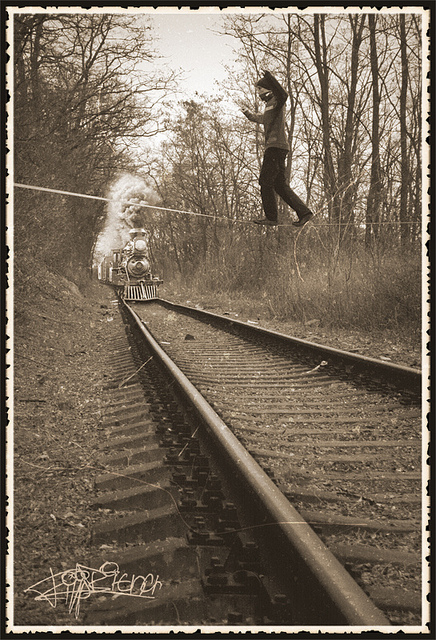As the sun warms and the snow melts, my blood rushes with excitement. Slacklining season is just around the corner.
I’ve been on the line, on and off, for the last two years. I first committed to practicing in the summer of 2015. Although it was only once a week to begin with, it was a start. And what a rewarding journey it has been! Find two trees, find hours of silence—how easy, how serene.
For those unfamiliar with this increasingly popular sport, slacklining is a balancing act in which one walks across a tightrope strung between two anchors. These are usually trees—or poles, tables, mountain peaks, et cetera.
The length of the line depends on one’s skill level and one’s desire to improve. The longer and narrower the line, the more difficult it is to find balance. The tighter the line, the easier it is to walk. Physically, it is demanding; mentally, it can be exhausting. Spiritually, it is incredibly grounding. These qualities probably account for why it is quickly developing a dedicated following throughout the world.
I spent last summer living out of my car in the beautiful valley of Winter Park, Colorado. Those few months were filled with adventure and discovery, with much credit owing to the slackline I constantly carried with me. I’d drive deep into the woods, find a silent paradise where I could set up camp, hang my line, and breathe in that crisp, cool mountain air.
My feet were free and often covered with weeks of dirt and grime; it was on the slackline that I discovered the incredible benefits of being barefoot.
As I sit here reflecting, I patiently await the return of warm weather and the physical, mental and spiritual balance that comes with walking a tightrope.
Since every lesson I’ve learned on the ‘line can be directly related to life, I’d like to share with you the insights my simple 50 dollar investment has ingrained:
1. Embrace The Wobbles.
The first step is the hardest. That quiver in your legs, that racing in your heart. You so badly want to be able to walk across, that at times you even try to run with the momentum. Frustration builds as you fight the movement and blame the line for its constant shakes and unstable ways, only to find out it’s the resistance above that’s holding you back.
Take a breath, center yourself, and embrace the wobbles as they come. Just like life, you have no control over what happens to you, but all the control on how you react.
Enjoy—even laugh at—the challenges as they arise. Any resistance will keep you stuck.
Welcome the obstacles and listen to what they can tell you. Once you can silently stand still in one place, you can confidently find yourself able to walk across with ease and grace.
2. Find Your Foundation.
Everything starts at the roots. Your feet are your foundation. Feel it out, feet first—find your center. Spread your toes, wrap them around the line, shift back and forth, and see where you feel most balanced.
We often think that the strength of a tree is determined by how tall it stands, when in fact, it is how well it’s rooted into the ground.
Often, the basics get left behind when that’s really where our focus should be. What is it that connects us to what we are doing, to what are we building from? As in life, where do we come from and how did we get here? We can’t move forward until we know where we started.
3. There Is Always a Reward.
Every time we step onto the line, we get better. Even if it’s only slightly, it’s a step in the right direction. Practice really is rewarding. In the moment, we sometimes don’t see the evolution. It’s only after a summer of play that we realize how much we’ve improved:
Mentally, we’ve found clarity. Physically, we’ve gained strength. With persistence and commitment, our souls, and our wellbeing, grow.
We must remember to pat ourselves on the back; whether it’s letting go of old habits, building new ones, or simply accepting things as they are, there is always a reward in hard work.
4. Balance.
Shimmy to the left, swing to the right. Everything is a balancing act. On the line, we sway back and forth until we finally find the center. In life, we will see happiness and pain, ups and downs, and we are often in darkness to find the light.
Everything has an opposite, and the only way to be centered is to accept life as a whole.
When we constantly react and judge the experiences that come up, this tends to create an imbalance, because we are on the lookout for these experiences, and stay stuck in a particular response pattern. When we take things as they are, we are more likely to find our center, true inner peace.
5. Patience.
The more we rush, the more we fall. When we don’t worry about the other side, the next adventure or tomorrow’s plans, events and situations tend to flow. No matter what, whatever preoccupies us will come soon enough. Being patient as we walk also means being hopeful and having faith in the future. We don’t need to accept the first job that comes our way, or worry that the job we have isn’t what we want long-term:
We can take whatever lessons we can from every step, and leave the anxiety and the future plans aside, because only time will tell.
6. If You’re Not Falling Down, You’re Not Improving.
Nothing worth having comes easily. If I’m not falling, I’m not improving. If I’m not improving, I’m not growing. If I’m not growing, I am wasting my time.
It’s okay when I fall down. I laugh at myself, get back up and try again.
I don’t need to fear failure, because this is the humility that puts me in my place. It teaches me what I need to change and pushes me to be better.
In other words, don’t let your stumbles hold you back from pursuing your dreams.
7. Never Look Down.
It is when we are lost focusing on the line that we tend to lose balance and sight. No longer are we looking forward to our goal. Rather, we’re stuck where we’ve already been.
We move in the direction our vision is set. If we are looking down, we fall down. If we look to the past, the past is where we stay. If we look too far in the future, we miss what’s happening now.
Being present means gazing toward the opportunities that consistently present themselves, often in plain sight.
8. No Two Days Are The Same.
One day you can blindly walk across with very little effort. The very next you find yourself struggling simply to stand.
It is so important to accept myself where I am, and to realize that every day is not the same. What I could accomplish yesterday may be a challenge today. What is a challenge today may be my strength tomorrow. It’s important to be gentle with myself and let go of my expectations.
When I build expectations, I am actually only just building a better cliff to jump off from.
The ideas you’ve created often lead to disappointment. Be okay with where you are, and know that tomorrow will most likely will be different.
9. Have Fun.
Have fun and don’t take it—slacklining, your relationships, work or life in general—too seriously.
(In a way, that’s all that has to be said!)
Spring is in the air, and as she slowly creeps in, I prepare for more lessons from the line. These lessons are just my reflections, and they don’t have to be found walking barefoot on a one inch-wide strip of webbing; everything is here to teach us something.
Where will you find your next life-changing insight?
All it takes is an open mind. With a welcoming attitude, we can all hear the lessons screaming through the silence. Have a beautiful day.
~
Author: Alyssa Johnson
Apprentice Editor: Sylvia Boss; Editor: Toby Israel
Image: Philip Bitnar/Flickr // Alessandro Valli/Flickr
~












Read 2 comments and reply